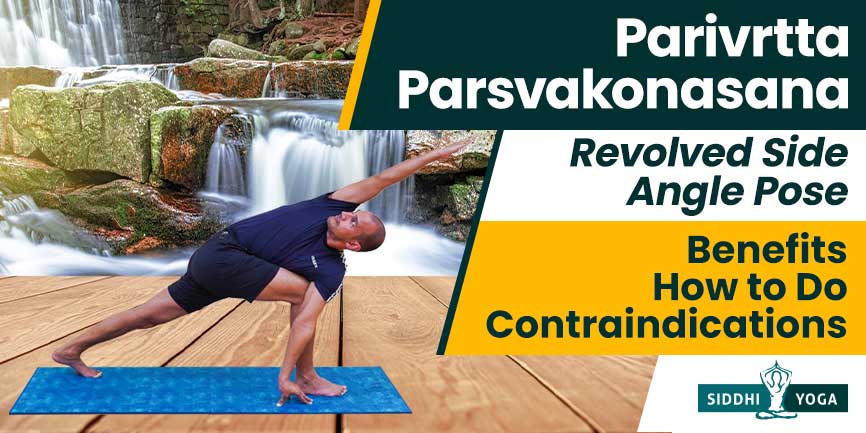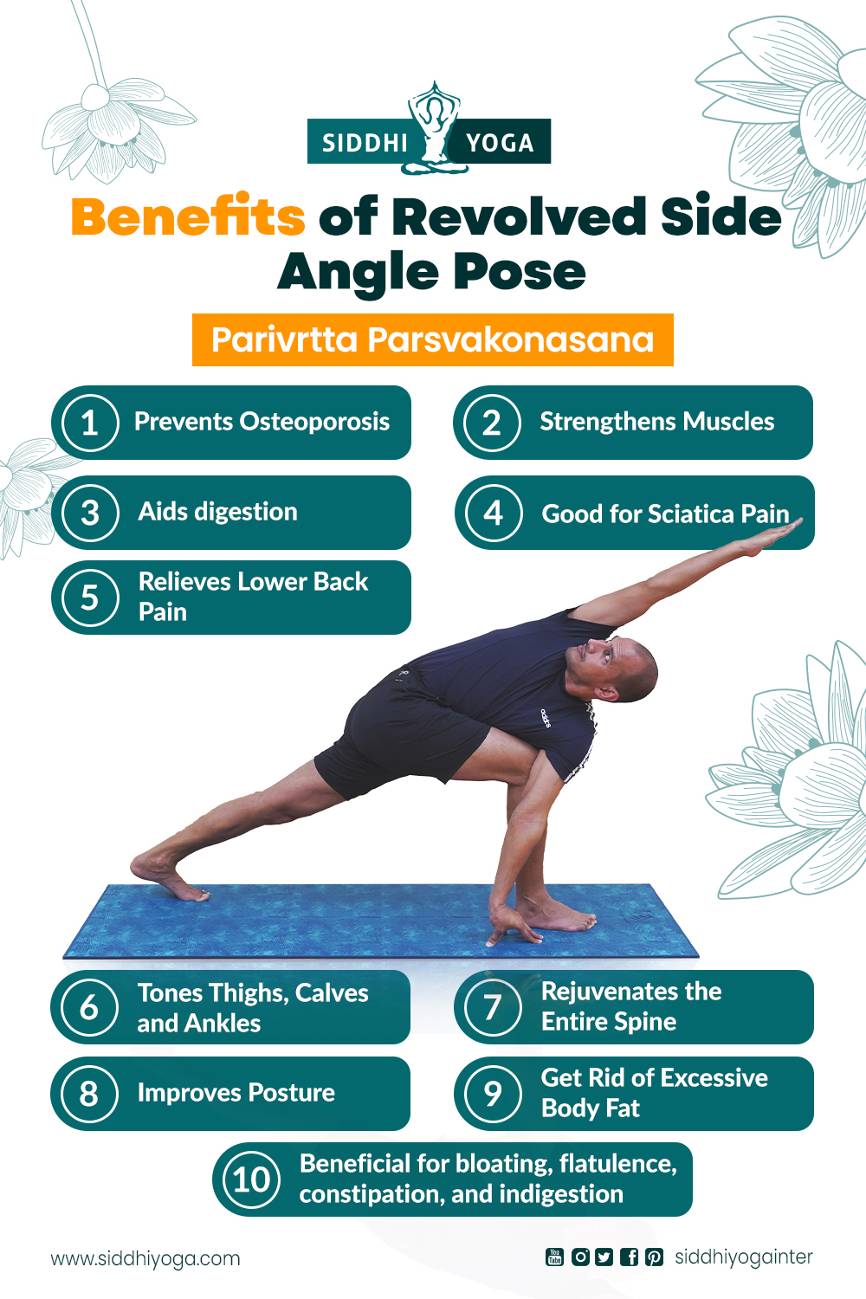
kona: “angle” āsana: “posture”
Parivrtta Parsvakonasana at a Glance
Parivrtta Parsvakonasana is a standing pose which is the coordination of the spinal twist with balance. It focuses on stretching, strengthening, and balancing your body with the coordination of the breath. This twisting pose helps to detoxify and improves blood circulation.
Benefits:
- It helps to strengthen your muscles, like Hamstrings, Hip Flexors, Glutes, and neck muscles.
- It gives a good stretch to your shoulders, arms, and legs.
- It improves the flexibility of the entire body.
- It helps to improve your self-awareness and concentration.
- It massages your abdominal organs, helps with the digestion process and keeps you away from constipation.
- It reduces your back pain, gives you a strong spine and improves your body posture.
Who can do it?
Individuals who have a good level of strength or flexibility can do this pose. Beginners can do this asana under the guidance of a trained yoga teacher. People who want to shed fat in the abdominal or hip area and improve their digestive system can do this asana regularly. People with mild respiratory issues can do this asana.
Who should not do it?
Pregnant ladies should avoid doing it. People with any kind of injury should consult their healthcare provider before doing or avoiding it. Individuals with very high or low blood pressure should avoid doing it. People with spinal issues, weak ligaments, or any severe stress or anxiety should avoid doing it.
How to Do Parivrtta Parsvakonasana?
Follow the Step-by-Step Instructions
Parivrtta Parsvakonasana is also a combination of Twist and Balance and an intense twist pose.
- Before you start the pose, do warm-ups and preparatory poses like Baddha Konasana, Downward Facing Dog, or Surya Namaskar. This will help your body to get into the Parivrtta Parsvakonasana pose easily.
- To start, you can start with the Tadasana and the Downward dog pose. Here we will start with the Tadasana (mountain pose) pose.
- Stand with your feet grounded, keep your spine straight, and your feet should be hip-width apart. Engage your core, and maintain a good, balanced, confident posture.
- Now create a distance between your feet, should be about 3 to 4 feet apart.
- Now take a deep breath and turn your right foot outward, keeping 90 Degrees to the right side and turn your left foot inside to about 45 degrees to the right. See that your right heel is in line with the left.
- Now inhale, and while you exhale, bend your right knee to create and deep lunge, and your right knee should be above your right ankle. The thigh is parallel to the mat.
- Join your hands (palms touching each other) in the prayer or namaste pose and keep your foot firm and balanced on the ground.
- Now again, inhale deeply, exhale, and twist your upper body towards your right side from the hip and keep your left elbow (left arm) on the right knee.
- There is another variation for the arms, you can just bring your left hand as you twist your upper body and place your left palm outside the right foot or inside the right foot, whichever is comfortable, and your right arm should be up, reaching the ceiling.
- For a deeper twist, you can again inhale and exhale and twist your upper body further and gaze in front of you, if possible, according to your comfort.
- This is the Parivrtta Parsvakonasana spinal twist position, and keep breathing gently while engaging the core, maintaining your balance, and being aware of bodily sensations.
- Be in this position for about 3 to 4 breaths or within your physical limitations.
- When ready to release, inhale and twist back your upper body, release your arms to the Tadasana, and relax for a few breaths.
- To balance your body, you can do it with the left leg (bend the left knee so the left thigh is parallel to the floor) at 90 degrees and the right at 45 degrees inward for the Revolved Extended side angle pose.
What are the Benefits of Parivrtta Parsvakonasana?

- Parivrtta Parsvakonasana is helpful with digestive problems. This pose helps massage your abdominal organs, which helps prevent indigestion, bloating, and constipation and relieves gastrointestinal discomfort.
- Parivrtta Parsvakonasana (Revolved Side Angle Pose) yoga pose helps to stretch and strengthen your knees, ankles, and thighs. This enhances your lower body strength and improves balance and stability.
- The Revolved Side Angle Pose helps to strengthen your legs, hips, hamstring, and spine.
- The Revolved Side Angle Pose helps the reproductive system of women as it stretches the lower back, the hip joints, and the pelvis.
- This deep lunge position helps to strengthen the quadriceps, hamstrings, and calf muscles, promoting leg stability and endurance.
- This pose helps to engage the core muscles, and thus it is very important to tone and strengthen the abdominal muscles, which can help with a better posture and overall core stability.
- This deep twisting pose helps to detoxify your body by removing the toxins from your internal organs.
- The twist and the deep stretch in this pose help to activate the parasympathetic nervous system, which helps with better relaxation and reducing stress.
- This pose helps to balance and strengthen your physical and mental body and improves your confidence level.
Health Conditions that Might Benefit from Parivrtta Parsvakonasana
- Regular practice of Parivrtta Parsvakonasana may help in managing mild arthritis and can help to relieve the pain and stiffness in the joints.
- When you practice yoga, asanas like Parivrtta Parsvakonasana can help in increasing good cholesterol and decreasing bad cholesterol and there can be a positive impact on the lipid panel.
- Parivrtta Parsvakonasana can have a positive impact on anxiety and helps to manage anxiety, improves sleep quality, and in turn, reduces stress levels occurring in your everyday life.
- Parivrtta Parsvakonasana asana can help in contracting and improving blood circulation to the abdominal organs, which helps to improve the digestion process. It can also help to manage acidity and help remove the waste matter through the colon without any strain, which helps to improve gastric function.
- Parivrtta Parsvakonasana improves blood circulation around the spinal cord due to the deep twist and stretch.
- Regular practice of Parivrtta Parsvakonasana can help relieve lower back pain and strengthen the muscles by supporting the spine.
- This pose provides an excellent hip and groin stretch, which can be helpful for people with stiffness or discomfort in these areas.
Safety and Precautions
- People with spinal and back injuries should avoid doing Parivrtta Parsvakonasana.
- People with knee injuries or severe knee pain should do this pose by taking safe measures and it’s better to do it under the guidance of your yoga teachers for safety.
- You should avoid practicing in the condition of migraine, vertigo, and headache, as this could worsen the situation.
- People with high blood pressure should avoid practicing or performing it under the guidance of a yoga teacher, and better to avoid very deep twists.
- People with low blood pressure should avoid doing this pose.
- Pregnant women should avoid doing the Parivrtta Parsvakonasana. Always do the warmup and some gentle stretches and preparatory poses before doing the Parivrtta Parsvakonasana
- If you have any flexibility issues with your knee or hips, use props to modify them to avoid more pressure.
- After releasing from the pose, some counter poses or cooling or relaxing poses that can be called Uttanasana (Standing Forward Fold Pose) bring the hips and shoulder to a neutral position.
- Be mindful and avoid forcing your body against your physical limits while performing the Parivrtta Parsvakonasana pose.
Common Mistakes
- Avoid arching the lower back as it can put more strain on your spine.
- Engage your core for better balance and support.
- Don’t shrug your shoulders, or it may create tension in your neck and shoulders.
- If you are a beginner, use props to improve your stability and alignment.
- Be aware of the breath and keep it flowing till you are in the pose and avoid holding it.
Tips for Parivrtta Parsvakonasana
- Use a yoga mat to do this asana to keep a grip on your feet.
- Warm-up is the important part, and so do the warm-ups and the preparatory to loosen your muscles.
- Keep your foot grounded and balanced.
- Your front knee should be over your ankle.
- The breath should be the guide to deepen the twist.
- Beginners should take guidance from a yoga teacher and respect their body limits.
- Don’t try to force the twist if it’s not possible, it will come your way with regular practice.
- Concentrate on balance and focus.
The Physical Alignment Principles for Parivrtta Parsvakonasana
- Start with the Tadasana, feet together and back straight.
- Hands should be in namaskar or prayer pose.
- Keep a gap of 3 to 4 feet between your feet.
- Turn the right foot to the right to 90 degrees and the left to 45 degrees inward.
- Turn your torso from the hip to the right leg side.
- keep your neck neutral so you don’t strain your cervical spine.
- Bend your right knee, and the bent knee should be just above (straight line) your ankle.
- The right thigh is parallel to the ground.
- Your hands should be in the prayer pose, and your elbow should be pointing up.
- Deeply inhale and exhale while you twist your torso to the right.
- The left elbow should be outside of the right knee.
- Your palms should be pressed against each other firmly
- Turn your head to the right and gaze up.
- Engage your core to get a better balance.
- Keep your arms active.
- Keep breathing continuously and deepen the twist using your breath.
- Be mindful of the alignment and be aware of it.
- If you are a beginner, use yoga blocks or consult your yoga trainer for guidance.
- Stay for 5 breaths, keeping your legs strong and your pelvic floor and lower abdominal muscles engaged, and repeat the same length on the other side with the left foot forward.
Parivrtta Parsvakonasana and Breath
Breath is a very important part of the Parivrtta Parsvakonasana for gaining better stability and comfort. As you are ready to move into the pose, just take a deep breath, come to prayer pose, lengthen your spine, and bend your right knee. Again, inhale and exhale while twisting your torso. Again, take a deep breath in and exhale for a deeper twist. And while you exhale, keep your core muscles engaged to twist your torso and release the tension. Again, inhale and exhale completely and twist a bit deeper if possible. Now when you are in the Parivrtta Parsvakonasana pose, keep breathing gently to balance and to maintain the stability of the pose. Mindfulness will keep you centered and help focus on the sensations in your body. Keep breathing and connect your breath with your mind and body.
Parivrtta Parsvakonasana and Variations
- Easy revolved side angle Pose with one knee on the floor.
- Revolved high lunge pose, twisting your upper body with the arms extended on the sides.
- Revolved eight-point crescent moon pose.
- Easy revolved side angle pose with a gentle twist, one knee on the floor, one hand on the knee, and one on the hip.
Take Away
Parivrtta Parsvakonasana, or Revolved Side Angle Pose, is a powerful standing pose with a deep twist that engages the entire body, promoting strength, flexibility, and balance. This pose helps to improve your spinal flexibility, improves your core strength, and helps with better digestion. It enhances leg strength and improves your balance and stability. It helps to improve your focus and concentration and helps reduce stress and tension. Follow the proper alignment procedure and in case you are a beginner, do this yoga practice under the guidance of a trained yoga trainer. For any health concerns, consult your health care professional.
Revolved Side Angle Pose increases your body awareness and you become more mindful. The twist in this pose helps to detoxify the body and connect the movement with your breath.
Seeking to deepen your yoga practice and share your love for yoga with others? Our certified 200-Hrs yoga teacher training multistyle, 300-Hrs yoga teacher training course, and 500-Hrs Yoga Teacher Training Courses are designed just for you! Embrace the transformative power of yoga, learn from expert instructors, and receive Yoga Alliance, USA certification upon completion. Whether you’re a beginner or a seasoned practitioner, these courses offer a unique opportunity to enrich your life and make a positive impact. Enroll now and take the leap toward becoming a certified yoga instructor!

Responses